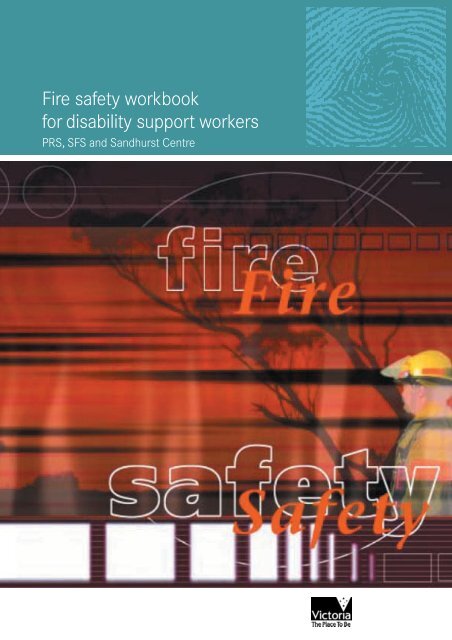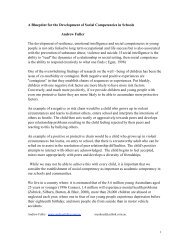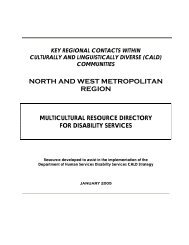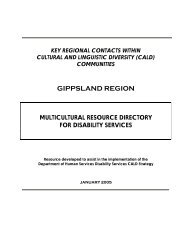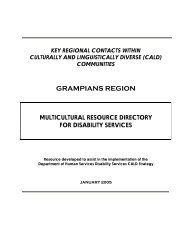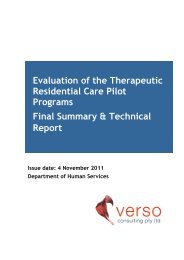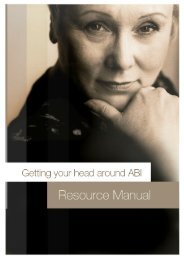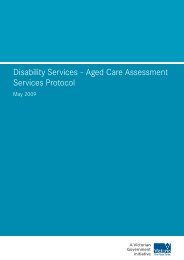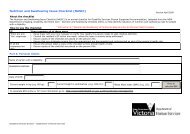Fire safety workbook for disability support workers - Department of ...
Fire safety workbook for disability support workers - Department of ...
Fire safety workbook for disability support workers - Department of ...
You also want an ePaper? Increase the reach of your titles
YUMPU automatically turns print PDFs into web optimized ePapers that Google loves.
<strong>Fire</strong> <strong>safety</strong> <strong>workbook</strong><br />
<strong>for</strong> <strong>disability</strong> <strong>support</strong> <strong>workers</strong><br />
PRS, SFS and Sandhurst Centre
<strong>Fire</strong> <strong>safety</strong> <strong>workbook</strong><br />
<strong>for</strong> <strong>disability</strong> <strong>support</strong> <strong>workers</strong><br />
PRS, SFS and Sandhurst Centre
2 <strong>Fire</strong> Safety Workbook <strong>for</strong> Disability Support Workers—<br />
PRS, SFS and Sandhurst Centre<br />
Written, designed and researched by:<br />
Melissa Young<br />
Training Consultant<br />
Disability Learning & Development Unit<br />
<strong>Department</strong> <strong>of</strong> Human Services<br />
With many thanks to…<br />
Brian Boldt<br />
Metropolitan <strong>Fire</strong> Brigade<br />
Based on previous contributions <strong>of</strong>:<br />
<strong>Department</strong> <strong>of</strong> Human Services<br />
Bryan McCarthy (<strong>Fire</strong> RiskManager)<br />
Melissa Young (Training Consultant)<br />
Metropolitan <strong>Fire</strong> Brigade<br />
Roy Marshall<br />
Anthony Murphy<br />
No part <strong>of</strong> this publication may be produced, stored in a retrieval<br />
system or transmitted in any <strong>for</strong>m or by any means electronic,<br />
mechanical, photocopying, recording or otherwise without the<br />
prior written permission <strong>of</strong> the copywriter owner.<br />
Copyrighted material reproduced herein are used either under the<br />
provisions <strong>of</strong> the Copyright Act (1968) as amended, or as a result<br />
<strong>of</strong> application to the copyright owner.<br />
© <strong>Department</strong> <strong>of</strong> Human Services Victoria 2003
PRS, SFS & Sandhurst fire <strong>safety</strong><br />
Introduction<br />
Welcome to this <strong>Fire</strong> Safety Workbook <strong>for</strong> staff working at either PRS, SFS<br />
or Sandhurst Centre.<br />
This <strong>workbook</strong> <strong>for</strong>ms part <strong>of</strong> your fire <strong>safety</strong> training and is also used <strong>for</strong> ongoing<br />
assessment <strong>of</strong> competencies every two years, to ensure you maintain skills in fire<br />
<strong>safety</strong> practices.<br />
The Disability Learning and Development Unit (DLDU), <strong>Department</strong> <strong>of</strong> Human<br />
Services has developed this <strong>workbook</strong> in consultation with the Metropolitan <strong>Fire</strong><br />
and Emergency Services Board.<br />
Support from your supervisor and team members is an integral part<br />
<strong>of</strong> this training.<br />
Throughout the <strong>workbook</strong> you will find text boxes like this one. These will<br />
indicate the points where you need to complete a task with your supervisor.<br />
Rationale<br />
<strong>Fire</strong> Safety Workbook <strong>for</strong> Disability Support Workers— 3<br />
PRS, SFS and Sandhurst Centre<br />
The purpose <strong>of</strong> this training is to give staff clear guidelines on their role in emergency<br />
management, and the basic principles <strong>of</strong> fire prevention and <strong>safety</strong>.<br />
The staff attending this program may have varying skills and educational levels.<br />
Likewise, some staff may have many years’ experience while others may have limited<br />
experience <strong>of</strong> fire <strong>safety</strong> and evacuation. It is the aim <strong>of</strong> this training to ensure that<br />
all staff demonstrate the required competencies <strong>of</strong> fire <strong>safety</strong> and evacuation.<br />
The following table demonstrates the relevant competencies within the Community<br />
Services Training Package against which this training is mapped.
4 <strong>Fire</strong> Safety Workbook <strong>for</strong> Disability Support Workers—<br />
PRS, SFS and Sandhurst Centre<br />
UNIT CHCOHS302A Participate in <strong>safety</strong> procedures <strong>for</strong> direct care work<br />
Element <strong>of</strong><br />
CHCOHS302A<br />
4. Identify other hazards<br />
and assess risk.<br />
5. Follow procedures<br />
and strategies <strong>for</strong><br />
risk control<br />
Per<strong>for</strong>mance criteria<br />
<strong>of</strong> CHCOHS302A<br />
4.1 Identify other hazards<br />
in the workarea during<br />
the per<strong>for</strong>mance <strong>of</strong><br />
duties.<br />
4.2 Assess level <strong>of</strong> risk<br />
5.1 Report hazards in the<br />
workarea to<br />
designated personnel<br />
according to<br />
workplace procedures<br />
5.2 Follow accurately<br />
workplace procedures<br />
and workinstructions<br />
<strong>for</strong> controlling risks<br />
with minimal<br />
supervision.<br />
5.3 Whenever necessary,<br />
within the scope <strong>of</strong><br />
responsibilities and<br />
competencies, follow<br />
workplace procedures<br />
<strong>for</strong> dealing with<br />
incidents, fire and/or<br />
hazardous events.<br />
Fer competencies CS-FP-001-1995, levels, units and elements<br />
Level 1, Unit 1 React Safely in an emergency situation<br />
Element 1.1 Prepare <strong>for</strong> emergency situations<br />
Element 1.2 Report emergencies<br />
Element 1.3 React safely to emergency signals and instructions<br />
Element 1.4 Evacuate from the endangered area<br />
Level 1, Unit 2 Help prevent emergencies<br />
Element 2.1 Correct or report problems that may lead to emergencies<br />
Element 2.2 Check, correct or report problems that may prevent<br />
emergencies from being safely handled<br />
Level 2, Unit 1 Operate as part <strong>of</strong> an emergency team<br />
Element 1.1 Operate as part <strong>of</strong> a floor or area emergency team<br />
Element 1.2 Cooperate with emergency service(s) personnel<br />
Element 1.3 Participate in training, exercises and critiques<br />
Element 1.4 Respond to emergency reports and signals<br />
Level 2, Unit 2 Control small uncomplicated emergencies<br />
Element 2.1 Evaluate the emergency<br />
Element 2.2 Safely confine emergencies<br />
Element 2.3 Use first attackemergency equipment<br />
Element 2.4 Report the use <strong>of</strong> first attackemergency equipment<br />
Level 3, Unit 2 Safeguard endangered persons<br />
Element 2.1 Respond to emergency reports and signals<br />
Element 2.2 Anticipate the behaviour <strong>of</strong> emergencies<br />
Element 2.3 Initiate and control any needed evacuation<br />
Element 2.4 Assist with miscellaneous emergency activities
Directions<br />
<strong>Fire</strong> Safety Workbook <strong>for</strong> Disability Support Workers— 5<br />
PRS, SFS and Sandhurst Centre<br />
It is important to read these directions carefully to be able to properly participate<br />
in this training.<br />
• The package consists <strong>of</strong> a training video ‘<strong>Fire</strong> Safety and Emergency Procedures<br />
Training Video’ and this self-paced training manual. This self-paced training<br />
manual has theoretical components and practical exercises and some exercises<br />
that need to be completed with your supervisor. It should take a total <strong>of</strong><br />
approximately 2 hours to complete the self–paced package.<br />
• Your supervisor is responsible <strong>for</strong> ensuring that each staff member participates<br />
in this training. It is preferable that where possible staff train together (in the<br />
environment that they work).<br />
• View the video first. The video presents critical components <strong>of</strong> fire <strong>safety</strong>,<br />
particularly in evacuation procedures. If you are a new staff member, you should<br />
view the video within the first week<strong>of</strong> commencement. If you are an existing<br />
staff member, you should view the video no later than one month <strong>of</strong> it becoming<br />
available.<br />
• Secondly, workthrough the self-paced training manual and complete this<br />
<strong>workbook</strong> sequentially from section one to section seven. The manual will give<br />
you clear instructions <strong>of</strong> what is expected <strong>of</strong> you.<br />
• Working through a self-paced manual allows you to set your own training plan<br />
and timelines.<br />
• In this participant booklet, please indicate your fire training commencement date<br />
and expected completion date in the space provided.<br />
• If you come across any difficulties when working through the package or have any<br />
questions, direct them to your supervisor or line manager.
6 <strong>Fire</strong> Safety Workbook <strong>for</strong> Disability Support Workers—<br />
PRS, SFS and Sandhurst Centre<br />
<strong>Fire</strong> <strong>safety</strong> <strong>workbook</strong><br />
Name:<br />
I viewed the video on:<br />
……/……/……<br />
I am expecting to finish this <strong>workbook</strong> by:<br />
(date <strong>of</strong> practical skills training and assessment)<br />
Task 1: With your supervisor complete a <strong>Fire</strong> Safety Orientation Checklist.<br />
Section 1: <strong>Fire</strong> awarness and prevention<br />
Task 2: With your supervisor complete a Weekly <strong>Fire</strong> Safety Checklist.<br />
Task 3: If any faults are detected while completing the Weekly <strong>Fire</strong> Safety Checklist, follow the Reporting Faults procedure.<br />
Questions – To test your understanding <strong>of</strong> fire awareness and prevention (circle correct answer)<br />
1.1 What are the four main reasons that fire occur?<br />
A. Neglect, Ignorance, Bad house keeping, Revenge<br />
B. Ignorance, Apathy, Carelessness, Arson<br />
C. Ignorance, Arson, Reward, Stupidity<br />
D. Neglect, Bad house keeping, Reward, Stupidity.<br />
1.2 Name the 3 elements required <strong>for</strong> a fire to occur:<br />
A. Flames, Oxygen, Combustion<br />
B. Heat, Combustion, Oxygen<br />
C. Heat, Oxygen, Fuel.<br />
1.3 Name the 3 ways to extinguish a fire:<br />
A. Cooling, Starving, Smothering<br />
B. Smothering, Dampening, Extinguishing<br />
C. Covering, Wetting, Extinguishing.<br />
……/……/……
1.4 N/A in congregate care<br />
1.5 <strong>Fire</strong>s in laundries occur mostly because <strong>of</strong>:<br />
A. Frayed cords, Smoking, Not emptying bins regularly<br />
B. Smoking, Leaving pots on the stove, Dirty filters<br />
C. Ironing, Bad house keeping, leaving pots on the stove<br />
D. Ironing, Dirty filters in dryers, Frayed electrical cords.<br />
<strong>Fire</strong> Safety Workbook <strong>for</strong> Disability Support Workers— 7<br />
PRS, SFS and Sandhurst Centre<br />
1.6 What are some precautions you should take in the storage and labelling <strong>of</strong> flammable materials?<br />
A. Tight fitting lids and no flammable materials kept on site at the House<br />
B. Correct Labelling and no flammable materials kept on site at the House<br />
C. Store flammable materials away from heat sources, and all items must be locked away<br />
D. Store flammable materials away from heat sources and correct labelling.<br />
1.7 What is the DHS policy on smoking in buildings?<br />
A. No smoking inside, smoking in designated areas only<br />
B. No smoking anywhere on property<br />
C. Smoking is allowed anywhere as long as all the residents agree.<br />
1.8 What type <strong>of</strong> key should staff have on them at all times?<br />
A. Only a key to open the front door<br />
B. Master<br />
C. Keys to open both exit doors.<br />
1.9 Most people die in fires due to:<br />
A. Heat<br />
B. Locked Doors<br />
C. No Escape Plan<br />
D. Smoke<br />
E. No Smoke Alarms.<br />
➞ C1.2<br />
➞ C1.2<br />
➞ C1.2<br />
➞ C1.2
8 <strong>Fire</strong> Safety Workbook <strong>for</strong> Disability Support Workers—<br />
PRS, SFS and Sandhurst Centre<br />
Section 2: Alarm Systems<br />
Questions – To test your understanding <strong>of</strong> smoke detectors (circle correct answer)<br />
2.1 How <strong>of</strong>ten are smoke detectors tested by a staff member or a contractor?<br />
A. Monthly<br />
B. Daily<br />
C. Weekly<br />
D. Yearly<br />
E. Never.<br />
2.2 N/A in Congregate care<br />
2.3 What do you do if you discover a fault with the alarm panel or smoke detector?<br />
A. Leave it until the next scheduled maintenance contractor comes to the house/unit<br />
B. Report the fault immediately to the Maintenance Help Deskand your line manager on duty<br />
C. Contact fire alarm company.<br />
2.4 What signals will you receive when a fire alarm operates in your building?<br />
A. Bell and pager in your building will operate<br />
B. Hooters in your building will operate<br />
C. Bells and hooter in your building operate.<br />
➞ C1.2<br />
➞ C1.2<br />
➞ C1.2
Section 3: Sprinkler systems<br />
Questions – To test your understanding <strong>of</strong> sprinkler systems (circle correct answer)<br />
<strong>Fire</strong> Safety Workbook <strong>for</strong> Disability Support Workers— 9<br />
PRS, SFS and Sandhurst Centre<br />
3.1 A sprinkler operates in the following way:<br />
A. As individual sprinklers. Heat from a fire expands the liquid in the bulb <strong>of</strong> the sprinkler head. This breaks the bulb<br />
and water is sprayed out over the fire<br />
B. Smoke will set <strong>of</strong>f all the sprinkler heads after two minutes<br />
C. Heat in one location will set <strong>of</strong>f all sprinkler heads in the building simultaneously.<br />
3.2 How <strong>of</strong>ten should staff in the house check the sprinkler system and pressure gauges?<br />
A. Daily<br />
B. Weekly<br />
C. Monthly<br />
D. Never, this is done by a maintenance contractor.<br />
3.3 A sprinkler control cabinet <strong>for</strong> your building is located:<br />
A. At the side or front <strong>of</strong> the building. Each building may differ slightly, but the cabinet will be identified<br />
in the Evacuation Plan<br />
B. In the staff sleepover/<strong>of</strong>fice<br />
C. In the kitchen.<br />
3.4 What is the purpose <strong>for</strong> checking the sprinkler system weekly?<br />
A. Making sure the contractor is doing their job<br />
B. Making sure the cabinet is locked<br />
C. Checking <strong>for</strong> damage and <strong>for</strong> appropriate water pressure levels.<br />
3.5 Who should you contact if you detect a fault in the sprinkler system?<br />
A. Leave it until the next scheduled maintenance contractor comes to the house<br />
B. Report the fault immediately to the Maintenance Help Deskand your line manager on duty<br />
C. Contact MFESB.<br />
➞ C1.2<br />
➞ C1.2
10 <strong>Fire</strong> Safety Workbook <strong>for</strong> Disability Support Workers—<br />
PRS, SFS and Sandhurst Centre<br />
Section 4: Evacuation procedures (theory)<br />
Task 4: Discuss with your supervisor, the possible evacuation order <strong>of</strong> everyone in the building subject to their<br />
room placement.<br />
Task 5: Discuss with other staff in your building (in the presence <strong>of</strong> your supervisor), the fire evacuation plan.<br />
Task 6: Discuss with your supervisor the most appropriate method <strong>for</strong> evacuating residents who use wheelchairs.<br />
Test the exit routes using any empty wheelchair.<br />
Questions – To test your understanding <strong>of</strong> evacuation procedures (circle correct answer)<br />
4.1 N/A in Congregate care<br />
4.2 A primary and secondary assembly area is needed because:<br />
A. Conditions may blockthe use <strong>of</strong> one area<br />
B. So that there are not too many people at the one assembly area<br />
C. So you can go to the nearest point when evacuating.<br />
4.3 What is your primary concern in a fire emergency?<br />
A. Life <strong>safety</strong><br />
B. Saving the house<br />
C. Putting the fire out<br />
D. Waking the neighbours<br />
E. Ringing your agency.<br />
4.4 The five steps you should take when discovering a fire are: Assist any person in danger, Close the door,<br />
Call 345, Evacuate, Remain at assembly area.<br />
A. True<br />
B. False<br />
➞ C 1.1, 2.2 & 3.2<br />
4.5 What is the reason that you close the doors on a fire?<br />
A. So you know no-one is in the room<br />
B. So you know which room is on fire<br />
C. To prevent damaging the rest <strong>of</strong> the house<br />
D. To prevent smoke spread<br />
E. Both A and D.<br />
➞ C2.2
4.6 Why should you check all rooms in the building when evacuating?<br />
A. Make sure all lights are turned <strong>of</strong>f<br />
B. See whether the fire has spread anywhere else<br />
C. To ensure everyone has evacuated.<br />
4.7 Why should everyone remain at the assembly area?<br />
A. It’s a good place to meet<br />
B. DHS policy<br />
C. Because I said so<br />
D. To checkeveryone is out <strong>of</strong> the building.<br />
4.8 N/A in Congregate care<br />
4.9 The importance <strong>of</strong> working as part <strong>of</strong> the emergency team is so you work more effectively<br />
in getting as many people evacuated as possible in the shortest time.<br />
A. True<br />
B. False<br />
4.10 The role <strong>of</strong> the emergency services is:<br />
• to assist in evacuation (if required)<br />
• verify reason <strong>for</strong> alarm<br />
• act accordingly to extinguish the fire (if any)<br />
• to reset alarm control panel, gas valves and sprinkler system<br />
• provide advice on fire <strong>safety</strong><br />
• order all clear to re-entry.<br />
A. False<br />
B. True<br />
4.11 What is the emergency phone number to call from inside this accommodation facility?<br />
A. 0-000<br />
B. 000<br />
C. 345<br />
D. 911<br />
<strong>Fire</strong> Safety Workbook <strong>for</strong> Disability Support Workers— 11<br />
PRS, SFS and Sandhurst Centre<br />
➞ C 1.1 & 3.2<br />
➞ C 1.1 & 3.2<br />
➞ C2.2& 2.2<br />
➞ C2.2& 2.2<br />
➞ C 1.1, 2.1 & 3.2
12 <strong>Fire</strong> Safety Workbook <strong>for</strong> Disability Support Workers—<br />
PRS, SFS and Sandhurst Centre<br />
4.12 What action will you take if fire is evident and alarm has not operated?<br />
A. BreakMCP or ring 0-000, assist person in immediate danger, evacuate, follow as directed by fire warden<br />
B. Send other staff member to other buildings<br />
C. Checksprinkler valves.<br />
➞ C 1.1, 2.1 & 3.2<br />
4.13 <strong>Fire</strong> doors in your building should be wedged open <strong>for</strong> easy access in an emergency:<br />
A. True<br />
B. False<br />
➞ C1.1<br />
4.14 <strong>Fire</strong> walls and fire doors delay the spread <strong>of</strong> smoke and fire from one side <strong>of</strong> the wall to the other side:<br />
A. True<br />
B. False<br />
4.15 The fire wall, fire doors and door frames should be maintained in original and good condition at all times:<br />
A. True<br />
B. False<br />
4.16 You don't have to evacuate a building in alarm if you realise it is a false alarm:<br />
A. True<br />
B. False, you should always evacuate<br />
➞ C 1.1, 2.1 & 3.2
Section 5: Evacuation procedures (practical)<br />
<strong>Fire</strong> Safety Workbook <strong>for</strong> Disability Support Workers— 13<br />
PRS, SFS and Sandhurst Centre<br />
Task 7: It may be possible that you participate in a house evacuation run by your Supervisor, prior to completing a <strong>for</strong>mal<br />
assessment. Evacuations should be documented using the Evacuation Exercise Record Sheet.<br />
A suitably qualified workplace trainer and assessor will also train you in the evacuation and will complete<br />
the <strong>for</strong>mal assessment, using the same <strong>for</strong>m.
14 <strong>Fire</strong> Safety Workbook <strong>for</strong> Disability Support Workers—<br />
PRS, SFS and Sandhurst Centre<br />
Section 6: Portable fire extinguishers and fire blankets<br />
Questions – To test your understanding <strong>of</strong> portable fire extinguishers and fire blankets<br />
(circle correct answer)<br />
6.1 – 6.4 N/A in Congregate care<br />
6.5 To use a fire blanket you:<br />
• Remove it from its storage case<br />
• Grip the two straps attached to fire blanket<br />
• Hold fire blanket at arms length<br />
• Approach fire cautiously<br />
• Gently place the fire blanket over the fire<br />
• Turn <strong>of</strong>f the heat source<br />
• Leave the fire blanket on pot and allow to cool<br />
• Call the fire brigade to ensure the fire did not spread to other areas (ie ro<strong>of</strong> spaces).<br />
A. True<br />
B. False<br />
➞ C2.2<br />
6.6 What does PASS stand <strong>for</strong>?<br />
A. P = Pull the pin, A = Aim the extinguisher, S = Squeeze the handle, S = Sweep the extinguisher from side to side<br />
B. P = Point the extinguisher, A = Aim close to base <strong>of</strong> fire, S = Squeeze handle, S = Sweep the extinguisher from<br />
side to side<br />
C. P = Pull the pin, A = Aim the extinguisher, S = Squeeze the handle, S = Suffocate flames.<br />
➞ C2.2<br />
6.7 N/A in Congregate care<br />
6.8 What should you do if a fire becomes bigger whilst using an extinguisher or fire blanket?<br />
A. Evacuate, because life <strong>safety</strong> is more important<br />
B. Continue applying extinguishing agent until the extinguisher is empty<br />
C. Try and find additional extinguishers or blankets to use.<br />
➞ C2.2
<strong>Fire</strong> Safety Workbook <strong>for</strong> Disability Support Workers— 15<br />
PRS, SFS and Sandhurst Centre<br />
6.9 Once you have used a fire blanket or extinguisher<br />
• Mark or identify it as being used<br />
• Report it as being used immediately (to your line supervisor/manager on duty)<br />
• Do not place a used portable fire extinguisher or fire blanket back in its assigned location.<br />
A. False<br />
B. True<br />
6.10 An extinguisher should be replaced when the pressure level is:<br />
A. Less than 10<br />
B. Outside the green area<br />
C. Less than 10 or more than 25.<br />
6.11 On what type <strong>of</strong> fires can you use a dry chemical extinguisher with a 20B(E) rating?<br />
A. Wood and paper only<br />
B. Electrical and wood only<br />
C. Wood, paper, furnishings, Electrical equipment, Flammable liquids, Cooking oil<br />
D. Cooking oil and gas only.<br />
Your practical Assessment <strong>for</strong> this section will be completed via a suitably qualified workplace trainer<br />
and assessor. You will be assessed to ensure you:<br />
• Identify the types <strong>of</strong> emergency control equipment and their limitations<br />
• Assess emergency situation and likely effectiveness <strong>of</strong> first attack action<br />
• Follow the procedures in the operation <strong>of</strong> emergency control equipment<br />
• Follow procedures after first attackequipment is used.<br />
➞ C2.2<br />
AS 3504
16 <strong>Fire</strong> Safety Workbook <strong>for</strong> Disability Support Workers—<br />
PRS, SFS and Sandhurst Centre<br />
Section 7: Other fire emergencies<br />
Questions – To test your understanding <strong>of</strong> other fire emergencies (circle correct answer)<br />
7.1 How do you protect yourself from radiant heat in a bush fire?<br />
A. Wet yourself down, or jump in a pool or dam<br />
B. Wear as little as possible so you don’t get too hot<br />
C. Cover yourself with clothing, sheets <strong>of</strong> barkor s<strong>of</strong>t earth, or lie down behind a log or large rock.<br />
➞ C 1.1 & 3.2<br />
7.2 What precautions should you take when you drive into smoke from a bush or grass fire?<br />
A. Slow down, switch on headlights and watch out <strong>for</strong> other vehicles, people or objects (including <strong>Fire</strong> Brigade)<br />
B. Drive quickly through smoke, so your visibility is only limited <strong>for</strong> a short time<br />
C. Do not drive through smoke under any circumstances.<br />
➞ C 1.1 & 3.2<br />
7.3 What items <strong>of</strong> <strong>safety</strong> equipment should you carry in your car?<br />
A. First Aid kit, fire extinguisher, breathing mask<br />
B. Large woollen blanket, water bottle, phone<br />
C. First Aid kit, map <strong>of</strong> the area/compass, breathing mask.<br />
➞ C1.1<br />
7.4 What are two types <strong>of</strong> car fires you can experience?<br />
A. Electrical fire, fuel fire<br />
B. Gas fire, paper fire<br />
C. Electrical fire, paper fire.<br />
7.5 You should get out <strong>of</strong> your car if caught in a bush/grass fire<br />
A. True<br />
B. False<br />
7.6 Who should you contact <strong>for</strong> more in<strong>for</strong>mation regarding rural fire <strong>safety</strong>?<br />
A. MFESB<br />
B. Local CFA fire brigade, CFA headquarters or regional <strong>of</strong>fice.<br />
7.7 What type <strong>of</strong> heat is a killer in a bushfire?<br />
A. Radiant<br />
B. Direct burning<br />
C. Conducted heat<br />
D. Convection heat.<br />
➞ C 1.1 & 3.2
<strong>Fire</strong> Safety Workbook <strong>for</strong> Disability Support Workers— 17<br />
PRS, SFS and Sandhurst Centre<br />
7.8 When caught in a bush/grass fire you should try and park you car on the barest ground available, or against<br />
an embankment in a cutting, or in an old gravel pit or roadside clearing, or on a section <strong>of</strong> road with the least<br />
amount <strong>of</strong> scrub.<br />
A. True<br />
B. False<br />
➞ C 1.1 & 3.2<br />
7.9 What should you make sure is always full <strong>of</strong> water during summer?<br />
A. Bathtub<br />
B. Sinks<br />
C. Watertank<br />
➞ C1.1<br />
7.10 What are types <strong>of</strong> fire you may be confronted with in a rural setting?<br />
A. Bushfires, Chemical fires<br />
B. Bushfires, Chemical spills<br />
C. Bushfires, Grass fires, Car fires.<br />
Task 8: Complete Bushfire Preparedness Checklist – Rural only (Appendix 6)
18 <strong>Fire</strong> Safety Workbook <strong>for</strong> Disability Support Workers—<br />
PRS, SFS and Sandhurst Centre<br />
Disability Learning and Development Unit <strong>Fire</strong> Safety Training<br />
Congregate Care Residential Services – <strong>Fire</strong> Safety Training<br />
Region:<br />
Date:<br />
Name:<br />
Work Location:<br />
Part 1.<br />
Please complete the following questions about the course / workshop to assist us in planning<br />
future sessions.<br />
1. What did you anticipate learning from this workshop?<br />
2. List the three most significant items/areas learnt, <strong>for</strong> you, from this workshop.<br />
a.<br />
b.<br />
c.<br />
……/……/……
3. Which part <strong>of</strong> the program was least useful? (Give reasons)<br />
4. How will you apply your learning in the workplace?<br />
5. What difference do you hope this will make to your work?<br />
6. What would help you further your skills in this area?<br />
<strong>Fire</strong> Safety Workbook <strong>for</strong> Disability Support Workers— 19<br />
PRS, SFS and Sandhurst Centre
20 <strong>Fire</strong> Safety Workbook <strong>for</strong> Disability Support Workers—<br />
PRS, SFS and Sandhurst Centre<br />
Part 2<br />
Please ✓ a number where appropriate.<br />
1. Content:<br />
What is your assessment <strong>of</strong> the course content?<br />
Irrelevant 1 2 3 4 5 Relevant<br />
Poor quality 1 2 3 4 5 High quality<br />
Balance between theory/discussion/activities<br />
Inappropriate 1 2 3 4 5 Appropriate<br />
2. Benefits:<br />
How valuable was the course to you?<br />
Waste <strong>of</strong> time 1 2 3 4 5 Highly worthwhile<br />
Not applicable on the job 1 2 3 4 5 Highly applicable<br />
3. Presentation:<br />
Trainers Name:<br />
Poor 1 2 3 4 5 Excellent<br />
Comments:
4. Any suggestions <strong>for</strong> future courses?<br />
5. Other comments?<br />
Thank you <strong>for</strong> your feedback!<br />
(Please return to trainer)<br />
<strong>Fire</strong> Safety Workbook <strong>for</strong> Disability Support Workers— 21<br />
PRS, SFS and Sandhurst Centre


